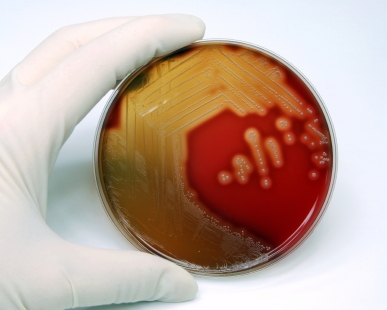 Some of the first available doses of penicillin were used to treat allied soldiers wounded on D-Day. It was the end of one war, but just the beginning of another–one that has gone on for a long time. The story of the development of antibiotics, and the emergence of resistant bacteria, followed by the renewed search for new antibiotics, seems neverending. As soon as a new antibiotic is discovered, it seems only a matter of time before a resistance mechanism emerges, and remaining one step ahead of the bugs can seem like a relentless challenge.
Some of the first available doses of penicillin were used to treat allied soldiers wounded on D-Day. It was the end of one war, but just the beginning of another–one that has gone on for a long time. The story of the development of antibiotics, and the emergence of resistant bacteria, followed by the renewed search for new antibiotics, seems neverending. As soon as a new antibiotic is discovered, it seems only a matter of time before a resistance mechanism emerges, and remaining one step ahead of the bugs can seem like a relentless challenge.
Although the initial discovery of penicillin was somewhat accidental, many other antibiotics have been discovered by first learning about the structure, physiology and life cycle of bacteria, and then using that knowledge to design/find drugs that target “weaknesses”—usually vital processes and structures that are present in bacterial cells, but absent from human cells. For example, bacteria have cell walls but eukaryotic cells do not, therefore, cell wall synthesis is a good target for antibiotics. Other targets include unique aspects of microbial protein synthesis, metabolism and DNA replication.
Penicillins, cepaholsporins and their derivatives all target cell wall synthesis. Aminoglycosides like Streptomycin and Gentamicin target protein synthesis by binding to the bacterial 30S ribosome subunit. Others like Rifampicin and Ciprofloxacin target microbial enzymes involved in RNA synthesis or DNA replication. Resistance occurs when bacteria develop the ability to inactivate the antibiotic, have mutations in the antibiotic target proteins, or develop alternative metabolic pathways.
In a sense most antibiotic strategies can be described as turning bacteria against themselves. They have all involved the development of agents, either naturally-occurring or man-made, that disrupt microbial metabolic and physiological pathways in a lethal manner while leaving human cells relatively untouched. In other words they all exploit knowledge of uniquely bacterial characteristics to design ways to kill bacterial cells. This week saw the publication of a study from researchers at Washington University School of Medicine describing a variation on this theme—one that raises the possibility of developing specific drugs that are active against an individual species, or only against virulent strains within a species—a much more specific approach.
Streptococcus pyogenes, the poster child for the beta-hemolytic Streptococci, causes a range of infections, including Strep throat and rheumatic fever. It produces a toxin, Streptococcus pyogenes β-NAD+ glycohydrolase (SPN), and is protected from the effect of its own toxin by a second protein, immunity factor for SPN (IFS). The paper Structural Basis of Streptococcus pyogenes Immunity to Its NAD+ Glycohydrolase Toxin, published in the Feb 9 edition of Structure, used analysis of the crystal structure of the SPN/IFS complex to show how this interaction occurs. The IFS protein binds to the active site of the toxin and blocks its interaction with β-NAD+. The bound form of the inhibitor undergoes a conformational change, and the unbound form is inactive. In the absence of the toxin, the inhibitor has a different conformation that is incapable of binding the toxin. The authors raise the possibility of exploiting this knowledge to create drugs that “lock” the inhibitor in its inactive form, rendering SPN-producing strains susceptible to their own toxin.
When I first saw the news items related to this paper, I thought that the authors had also identified some candidate molecules that might do this, but that is not the case. The paper describes the mechanism of this particular toxin-inhibitor interaction, and reports the conformational change in the inhibitor. It does not go so far as to identify a potential inhibitory compound. If and when it occurs, that will be a truly exciting development in the ongoing search for new antibacterial agents.
Structure Paper:
![]() Smith CL, Ghosh J, Elam JS, Pinkner JS, Hultgren SJ, Caparon MG, & Ellenberger T (2011). Structural Basis of Streptococcus pyogenes Immunity to Its NAD(+) Glycohydrolase Toxin. Structure (London, England : 1993), 19 (2), 192-202 PMID: 21300288
Smith CL, Ghosh J, Elam JS, Pinkner JS, Hultgren SJ, Caparon MG, & Ellenberger T (2011). Structural Basis of Streptococcus pyogenes Immunity to Its NAD(+) Glycohydrolase Toxin. Structure (London, England : 1993), 19 (2), 192-202 PMID: 21300288
Science Daily coverage of this story: Turning bacteria against themselves.
Isobel Maciver
Latest posts by Isobel Maciver (see all)
- 3D Cell Culture Models: Challenges for Cell-Based Assays - August 12, 2021
- Measuring Changing Metabolism in Cancer Cells - May 4, 2021
- A Quick Method for A Tailing PCR Products - July 8, 2019

You should look at what polymedix is developing.